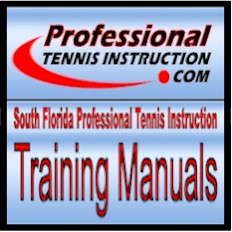|
Footwork
By: Andrew S. Rosz
South Florida Professional
Tennis Instruction
Hollywood, Florida , USA
(954) 922-8040
FOOTWORK BASICS
When several steps are required in chasing down a ball, two general rules can be
applied.
- When moving toward the ball: The first step is made with the leg closest to the ball.
That is, if you are about to move toward a forehand, move the right leg first.
- When moving away from the ball: The first step is made with the leg closest to the ball
but this is where sideways and backward stepping is commonly required. Since this is more
difficult than moving toward the ball, react quickly and move SLOWLY to maintain your
sense of balance. If you balance is lost, not only do you loose control of your shot, but
you also risk personal injury due to a fall and/or a twisted ankle.
When not having to move at all to chase down a ball, that is, when only a TM2 sideways
rotation is required, only two steps are necessary. Step one is to move the leg on the
same side of the hitting side first. Specifically, move this leg (and foot) behind the
other foot when beginning the body rotation. Step two is to move the other leg so that
it's knee is facing four o'clock on forehands (or eight o'clock on backhands). In this
position, both knees should be slightly bent. This concept is the TM2 compliment for the
two-step stroke technique of TM1. In summary, step backward first, then step to the side.
NEVER step forward into your shots unless more than two steps are necessary.
GENERAL CONCEPTS OF FOOTWORK
- Footwork and the forward stroke: This concept was covered in the "Form and
Balance" lesson.
- Which leg to move first: As a general rule, move the leg closest to the ball first.
- When to begin to move: As soon as humanly possible. This means react quickly so you can
get to the ball with plenty of time to spare.
- How to move: Move smoothly without forceful steps. When moving sideways or backward,
crouch down slightly to lower your center of gravity.
- Heel-toe vs. toe-only stepping: Most steps are done with the body weight on the front of
the feet (toe-only stepping). This allows for efficient pivoting and proper positioning of
the feet. Heel-toe stepping is appropriate only in extreme running situations.
- The quantity of steps: As a general rule, the fewer the better. Minimizing your steps
will help you to conserve energy.
- The size of the step: Whatever is comfortable for you. Keep in mind however that smaller
steps are generally more controllable than larger steps.
- Accelerating the body: Do so smoothly. Begin with short steps, then make the steps
longer.
- Slowing down the body: Do so gradually. Always end with a sequence of at least two or
three very small steps to "fine tune" proper position and balance.
- Tennis shoes: Wear the shoes out, don't wear your feet out. This means play tennis
without concern over soiling your pretty new shoes. Tennis is demanding on both shoes and
rackets.

|
Note: Each of the tennis
tips outlined above are more fully discussed in a series of
expertly-written tennis instruction training manuals and book publications
for players who prefer to be "self-taught." For more
information on our world-renowned SFPTI tennis instruction
training manuals and book publications CLICK
HERE. |
Back
|